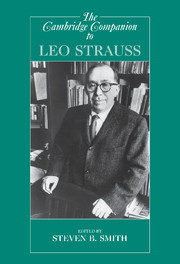Book contents
- Frontmatter
- 1 Introduction: Leo Strauss Today
- 2 Leo Strauss: The Outlines of a Life
- 3 Leo Strauss and the “Theologico-Political Predicament”
- 4 Strauss’s Recovery of Esotericism
- 5 Strauss’s Return to Premodern Thought
- 6 Leo Strauss and the Problem of the Modern
- 7 The Medieval Arabic Enlightenment
- 8 “To Spare the Vanquished and Crush the Arrogant”: Leo Strauss’s Lecture on “German Nihilism”
- 9 Leo Strauss’s Qualified Embrace of Liberal Democracy
- 10 Strauss and Social Science
- 11 The Complementarity of Political Philosophy and Liberal Education in the Thought of Leo Strauss
- 12 Straussians
- Bibliography
- Index
- Series List
4 - Strauss’s Recovery of Esotericism
Published online by Cambridge University Press: 28 November 2009
- Frontmatter
- 1 Introduction: Leo Strauss Today
- 2 Leo Strauss: The Outlines of a Life
- 3 Leo Strauss and the “Theologico-Political Predicament”
- 4 Strauss’s Recovery of Esotericism
- 5 Strauss’s Return to Premodern Thought
- 6 Leo Strauss and the Problem of the Modern
- 7 The Medieval Arabic Enlightenment
- 8 “To Spare the Vanquished and Crush the Arrogant”: Leo Strauss’s Lecture on “German Nihilism”
- 9 Leo Strauss’s Qualified Embrace of Liberal Democracy
- 10 Strauss and Social Science
- 11 The Complementarity of Political Philosophy and Liberal Education in the Thought of Leo Strauss
- 12 Straussians
- Bibliography
- Index
- Series List
Summary
Leo Strauss presented himself as a partisan of ancient and medieval Platonic political philosophy while emphasizing the esoteric character of that philosophy and its artful sheltering of the true teaching in a moral or edifying teaching it judged necessary. It is reasonable to suspect that a partisan of esoteric philosophy would himself write esoterically. The following essay aims to confirm that suspicion by looking first at Strauss's recovery of esotericism and then at his restoration of esotericism, his redeployment of the classical strategy for philosophic communication. / 1938-39: Recovery / Strauss's actual recovery of esotericism, caught in the act as he discovers just what it is, can now be read in letters to Jacob Klein from January 1938 to November 1939. The letters surge with the exhilaration, even the hilarity of serial discoveries spread across twenty-two months of precarious living for Strauss. In Heinrich Meier's metaphor, they contain “a whole series of philosophical supernovas ” that can serve Strauss's readers as orienting points for renewed study of his writings. Strauss's letters on esotericism begin with his first letter from New York on January 20, 1938. Amid the rigors of travel and failure to find a teaching position, Strauss reports that “Maimonides is getting more and more exciting” (545).
- Type
- Chapter
- Information
- The Cambridge Companion to Leo Strauss , pp. 63 - 92Publisher: Cambridge University PressPrint publication year: 2009
- 8
- Cited by



